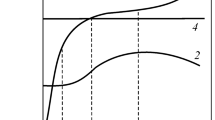Abstract
In processes of metal formation at an elevated temperature, the fracture criterion should depend at least on the parameter of a triaxial stressed state, the equivalent strain rate, and the temperature. This significantly complicates the investigation in comparison with the case of cold processing. However, in the case of fracture initiation at the free surface under plane-strain conditions, a computational scheme is found that is similar to the one used in processes of cold working under pressure, although in another space. This scheme is used for the prediction of the beginning of the fracture in the process of the simultaneous bending and straining of a wide bar.
Similar content being viewed by others
References
Kolmogorov, V.L., Plastichnost’ i razrushenie (Plasticity and Failure), Moscow: Metallurgiya, 1977.
Atkins, A.G., Fracture in Forming, J. Mater. Process. Nechnol., 1996, vol. 56, pp. 609–618.
Vilotic, D., Plancak, M., Gribc, S., Alexandrov, S., and Chikanova, N., An Approach to Determine the Work-ability Diagram Based on Upsetting Tests, Fat. Fract. Engng. Mater. Struct., 2003, vol. 26, no. 4, pp. 305–310.
Ogawa, N., Shiomi, M., and Odakada, K., Forming Limit of Magnesium Alloy at Elevated Temperatures for Precision Forming, Int. J. Mach. Tools Manufact., 2002, vol. 42, pp. 607–614.
Alexandrov, S., Wang, P.T., and Roadman, R.E., A Fracture Criterion of Aluminum Alloys in Hot Metal Forming, J. Mater. Process. Technol., 2005, vol. 160, no. 2, pp. 257–265.
Lyamina, E., Application of a Ductile Fracture Criterion for Fracture Prediction at Elevated Temperature, Steel Research Int., 2008, vol. 79 Special Edition vol. 2, pp. 369–374.
Alexandrov, S., Kim, J.-H., Chung, K., and Kang, T.-J., An Alternative Approach to Analysis of Plane-Strain Pure Bending at Large Strains, J. Strain Analysis for Engng. Design, 2006, vol. 41, no. 5, pp. 397–410.
Hill, R., Matematicheskaya teoriya plastichnosti (Mathematical Theory of Plasticity), Moscow: Gostekhizdat, 1956.
Ashby, M.F., and Johnes, D.R.H., Engineering Materials 1: Introduction to their Properties & Applications, Oxford: Butterworth-Heinemann, 1996.
Author information
Authors and Affiliations
Additional information
Original Russian Text © S.E. Aleksandrov, E.A. Lyamina, 2009, published in Problemy Mashinostroeniya i Mashin, 2009, No. 5, pp. 40–47.
About this article
Cite this article
Aleksandrov, S.E., Lyamina, E.A. Fracture prediction under the simultaneous bending and straining of a wide bar at an elevated temperature. J. Mach. Manuf. Reliab. 38, 448–454 (2009). https://doi.org/10.3103/S1052618809050070
Received:
Published:
Issue Date:
DOI: https://doi.org/10.3103/S1052618809050070




